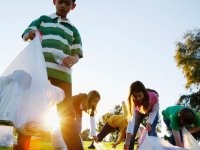Making Earth Day More Than Just a One-Day Celebration
Resources for connecting project-based learning to Earth Day—for students of all ages.
Your content has been saved!
Go to My Saved Content.With Earth Day 2017 coming up on April 22, many schools are making plans for one-day celebrations that promote a green message. For deeper learning—and longer-term benefits for people and our planet alike—why not use Earth Day as an opportunity to launch more ambitious projects?
Get on the Bandwagon
In 1970, more than 20 million Americans participated in the first Earth Day. I remember joining an impromptu parade of students who rode bikes to school that day instead of taking the bus. Unfortunately, our enthusiasm for clean transportation didn’t last. Sustainability wasn’t yet in our vocabulary.
This year, more than a billion people are expected to take part in Earth Day events around the world. More events will happen during National Environmental Education Week, April 23–29 (the week after Earth Day). Watch for updates at the website of the National Environmental Education Foundation.
Help your students consider their long-term role as environmental stewards by planning global education projects that challenge students to think (and act) beyond their classrooms.
Set Your Own Local Goals
The Global Goals for Sustainable Development, adopted by world leaders at a United Nations summit, focus on 17 topics that demand the world’s attention. They range from encouraging responsible consumption to improving access to clean water to ending hunger. Think about how these real-world goals connect to your content area and to your students’ interests. Then consider how to make these lofty goals right-sized for your students so that they aren’t overwhelmed by the challenge.
To design projects with sustainability at the center, look for a local focus to make issues more accessible and actionable for students. For example: How responsible are my family’s shopping habits? How can we make our school greener? How can we improve access to affordable fresh produce in local food deserts? How might we amplify the impact of organizations working to restore local ecosystems?
And don’t hesitate to let students lead when it comes to finding solutions. For example, students in Eugene, Oregon, convinced their city council to pass the first-ever local climate recovery law in the U.S. Youths in other communities are following their lead, creating local chapters of YouCAN, a program of Our Children’s Trust, which offers downloadable resources for taking local climate action.
Natural Heroes: Role Models for Environmental Action
A documentary called “A Simple Question: The Story of STRAW” shows what’s possible when a teacher takes her students’ questions seriously. In the 1990s, Laurette Rogers explained to one of her fourth-grade classes the concept of endangered species. A student asked, “What can we do?” That question launched a program that’s become an enduring citizen science project. STRAW—Students and Teachers Restoring a Watershed—engages hundreds of schoolchildren in watershed restoration efforts across Northern California.
How can your students learn from environmental action heroes, including those former fourth graders and their innovative teacher?
Natural Heroes is an award-winning public television series from KRCB. It features independent films (including “A Simple Question: The Story of STRAW”) about people who are making a positive difference when it comes to the environment.
To bring this rich multimedia content into the classroom, KRCB has produced a free guide that outlines six project-based learning plans aligned to the Common Core. (Full disclosure: I teamed up with KRCB to develop these multimedia PBL plans.) The 46-page Natural Heroes guide is free to download and includes links to short video selections from the series.
Project plans include options for elementary, middle, and high school and incorporate a wide range of subject areas, from environmental science and STEM to language arts and service learning. Each project idea starts with a driving question and suggested entry event, and concludes with students taking action or sharing the results of their investigation with a public audience.
Get Out There
Looking to connect your students with the natural world beyond the classroom? Check out Hands on the Land, a national network of field classrooms including national parks, wildlife refuges, and other special places. Network partners customize hands-on experiences using local natural, historical, and archaeological settings to bring classroom learning to life. If your students are doing a project that would benefit from connecting with experts in natural history, start here. And don’t miss the educator resources contributed by members.
